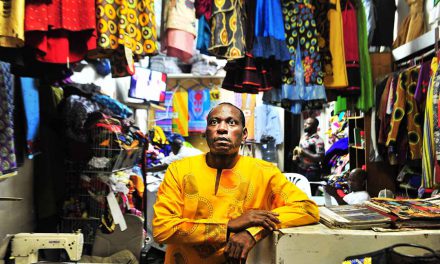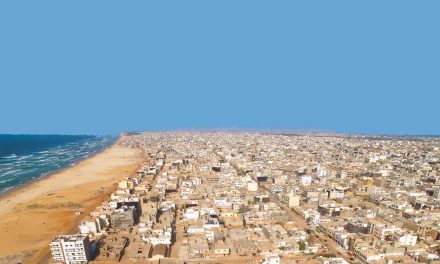
Informal brickmaking in Kampala, Uganda. Photo: Denver Smith,
African city governments face complex challenges, but they have many good governance tools at their disposal
Cities are a recent phenomenon in Africa. In 1950, there was not a single city with a population of over one million in Africa; today there are around 50. Many of the continent’s burgeoning cities – among them Accra, Nairobi, Lagos and Johannesburg – swelled in the second half of the last century. Lagos’s population grew five-fold between 1960 and 1990.
What makes Africa’s urbanisation unique is its scale and speed. According to a 2014 UN report, Africa’s urban population is projected to triple by 2050. Except for the recent faster economic growth experienced by many African countries, for the most part Africa’s rapid urbanisation has not been accompanied by a commensurate growth in income. As a result, investment in cities has lagged, while their populations have continued to grow without proper planning, making African cities segregated, chaotic and expensive.
African cities hold the promise of growth and structural transformation, but they also face serious challenges, manifested in growing unemployment, slums and informal economy. Though the challenges are complex and daunting, African cities can turn them into opportunities. With the right policy and institutional environment, leadership and commitment, much can be improved.
A range of planning and management tools exist that African cities can adapt and apply. There are also the experiences of those who have implemented them, or similar ones, around the world. In this article I will refer to four such tools to which I have some personal exposure; my experience with them offers some opportunities for reflection.
There are three fundamental questions relevant to urbanisation in Africa. Can Africa’s cities absorb their growing populations while at the same time keeping their environments less chaotic? Where is the money for proper urban planning and development? How can African cities promote their local economies and ensure job creation? The four tools we are concerned with are all based on the idea that the answers to these three questions intersect in the urban space, in the economy and in finance.
The most fundamental condition for good urbanisation is the ability to anticipate and plan for it. Many African cities began as villages, trading posts or railway stations before they morphed into today’s agglomerations. Because they were not projected to grow as fast as they did, and did not plan accordingly, land was not developed and infrastructure and service delivery were not expanded. The result is cities with dual economies, where a prosperous, often “enclave” economy is juxtaposed with sprawling informality.
Planning for urban growth of between 25 and 30 years and reversing the trend toward dual economies, in which informality is the de facto option for the majority, is a number one priority for planners with an eye on the future. This is particularly crucial in the case of rapidly growing primary and secondary cities. The idea isn’t novel; it is a basic practice of all successful cities. Some cities that are not rich, such as Ouagadougou, have implemented good planning practice in the past but did not sustain it.
Cities and governments in Africa are aware of this, although many have not done much about it. For a number of years, I was associated with the participatory planning approach that cities such as Dar es Salaam (Tanzania) and Ismaila (Egypt) implemented in the 1990s. At the time, localising Agenda 21, which was adopted at the 1992 United Nations Conference on Environment and Development (UNCED), gave considerable traction to the idea that environmental issues were useful entry points to successful urban planning.
The idea was to build urban development plans from the ground up, through issue-specific local solutions that would reconcile competing priorities and conflicts in respect of land and resource use. Technical tools, including city profiling, issue prioritisation, and land and resource mapping, were used. Participatory decision-making tools fostered information sharing and consensus building. Addressing issues such as waste management illustrated the complexity of urban issues and their governance, as well as the complementary roles of formal and informal sectors.
At a project level, the tools demonstrated the virtue of engaging stakeholders and communities in producing collective actions, as well as some of the drawbacks of so-called “master planning”. The experience generated immense awareness about urban issues and challenges, as well as of the importance of coordinated urban management. But it was process and capacity intensive and not fully embedded in the relevant urban-planning institutional and legislative structures. These challenges prevented this approach from going to scale to the point where city managements were focused on future urban growth.
The main constraint to long-term planning has always been implementation. The requisite institutional and financial capacity is always in short supply. But some more recently developed tools promote an incremental approach that focuses the initial effort on land acquisition and protection of rights of way, followed by multi-year phased investment. This is strategic and pragmatic.
Ethiopia, with support from the New York University Stern Urbanization Project, has applied this approach in four of its secondary cities: Adama, Bahir dar, Hawassa and Mekele. In a period of eight months during 2013/2014, the project secured the land required for the growth and expansion of the four cities in the coming three decades. This approach is now being replicated in other Ethiopian cities.
According to a 2015 study by the Ethiopia Urban Expansion Initiative, the process first projects the trend in population growth in each city. On that basis, a concept plan and arterial grid plan are prepared. This forms the basis for the expansion of the administrative territory of the cities. UN-Habitat has a similar initiative that brings planning and land-based financing tools together in a concrete local context. The approach has been piloted in Egypt, Rwanda and Zambia, but these are early days for a full assessment of its impact.
Good planning should leverage the increasing land value that results from impending urban development and associated wealth creation. Urban planning can be paired with land-based financing tools such as leases, property and land tax, capital gains tax, betterment levies, developer exaction and the sale of development rights.
Planning-in-advance approaches allow cities to provide the spatial form and connectivity needed to support productive economies. The economic benefits accruing from such public investment can be ploughed back into the city to create a virtuous cycle of development. The UN-Habitat planning approach mentioned above undertakes assessment of municipal finance and explicitly promotes land-based financing tools as part of the urban-expansion planning process.
Long-term urban expansion plans require considerable resources, and cannot be funded through land revenue alone. In Rubavu, Rwanda, one of UN-Habitat’s pilot projects, the long-term expansion plan’s preliminary budget amounted to over $100 million – a very large amount for a city with a per capita budget of less than $50. Nonetheless, land provides the seed money to get started, and augments national transfers.
Further, since implementation is phased in a multi-year programme, the immediate cash-flow needs are modest. Soon after approving their concept plan and grid layouts, the four Ethiopian cities mentioned above paid compensation for the acquired land and, in some cases, proceeded to implement the first phase of land and road development using the revenues they had generated from land lease. In one particular case, former landowners agreed to swap their compensation claims for developed future plots, decreasing the immediate cash needs of the city.
With or without urban planning, land-based financing offers a great opportunity for African cities. Land tax and property fees account only for only 0.5 % of GDP across sub-Saharan Africa, according to a 2012 academic study by Odd-Helge Fjeldstad and Kari Heggstad. These potential sources of government income are underused in Africa. In recent times, some cities have embarked on new tax regulations and reforms to exploit this opportunity.
In 2013, for instance, Nairobi’s city government introduced a land tax based on land and building structures rather than unimproved land only, aiming to double its revenue from this source. Land-tax rates in Nairobi had been based on the 1980 valuation roll and only 125,000 of the estimated half a million properties were paying rates, according to a September 2014 article in Business Daily, a Kenyan news outlet.
Since the turn of the century in Lagos, successive state governments have professionalised land-tax administration. First, three rates were consolidated into one – a land-use charge – replacing tenement, ground rent and neighbourhood improvement charges. Following this, the city’s recorded inventory was expanded using digital technology. Along with this, tax assessment and collection were improved, and education and outreach programmes conducted to support Lagosian’s willingness to pay taxes. The city substantially increased its revenue from this source, according to a 2015 Africa Research Institute report.
This approach isn’t only appropriate for bigger, richer cities; poorer cities can also improve their local finances with similar initiatives. Between 2007 and 2010, for instance, following the civil war in Sierra Leone, the city councils of Freetown, Bo, Makeni and Kenema increased their income from property tax by between three to five times. This was achieved using a simplified, IT based and transparent assessment and collection system to expand the record of property and improve compliance.
In Somaliland, the city of Hargeisa introduced, in 2005, a simple and transparent valuation method – automated billing using ICT tools that expanded the property record and improved data collection, including the use of satellite information – that increased the city’s tax base.
While enforcement, education and outreach are important elements for improving tax collection, successfully sustaining compliance depends on trust and public confidence. People will be willing to pay their taxes when they know where their money goes, and when they see that there are no leakages and waste. Participatory budgeting is one good tool to achieve that. Tailored to African realities and local context, and supported by UN-Habitat, participatory budgeting has been implemented in the recent past in DRC, Senegal and Mozambique, although it did not go further than pilot projects.
Ultimately, economic performance is key to the success of African cities. Cities that fail to spur growth and create jobs will find it increasingly difficult to govern and prosper. Taxes cannot grow without a growing economy. Though economic development is largely a national concern and responsibility, city authorities play a crucial role in harnessing local resources and competitive advantages. Local Economic Development (LED) planning tools are instrumental in this regard.
Fully fledged LED activities in sub-Saharan Africa are limited and sometimes confused with community development, but countries and cities often adapt or implement some LED elements, such as policies for small and medium enterprises, information and communication technology, green building, and aspects of the informal economy. These are sometimes initiated by central governments, one example being the enterprise development and job-creation components of Ethiopia’s housing and construction programme. In other cases, they are implemented by NGOs and the private sector as, for example, iHub in Nairobi, which was established in 2010 as a platform to connect and drive business start-ups in ICT solutions and innovations.
LED’s uptake in Africa has been slow or limited, and this is partly due to institutional reasons. South Africa is an exception. Africa’s southernmost country has accumulated experience in LED activities in its cities, including some rural towns facing economic distress. Cities show a keen interest in LED when their economies face traumatic transition following the closure of a traditionally important industry, such as mining. For example, in some cases, they can lose their economic role, as a transport hub or market centre. Such questions of timing, and pressure for immediate results, sometimes shifts the focus to quick-win projects at the cost of strategic actions that are institutionally and politically demanding but transformative.
African city governments face complex challenges, but they have many good governance tools at their disposal, such as the ones outlined above. When well designed and supported, these tools can be effective – but more fundamentally when they are driven by local champions and local demand. They are not prescriptive, and require adaptation to local context and sustained use to effect change. This makes local capacity an essential condition, and leadership a critical factor if the use of these tools is to bear fruit.
In Sierra Leone’s municipal finance reform, for example, three of the municipalities underwent similar processes while drawing on external support. The municipality of Bo’s relatively stronger success was partly due to its leadership.
But capacity is always an issue. UN-Habitat has helped some African cities to identify easy wins with regard to local revenue. However, it has often been the case that reforms remain limited to fragmented actions or assessment reports. Implementation requires capacity. It also involves long-term engagement and upfront investment, and may need mentoring. There is no shortage of urban support programmes, but often they are short term. Focusing on analytical work is critically important, but needs follow-up and support.
My own experience has been that, in many cases, the challenge is not the initial application of tools, but rather their sustained use and institutionalisation. The participatory planning approach that I referred to above is illustrative. In the early 1990s and 2000s, the programme helped a number of cities in Egypt, Ghana, Morocco, Nigeria, Tanzania and Zambia to build capacity to support better planning and management, using environmental issues as entry points.
The need to embed the tools, and the urban planning practices associated with them, in a lasting institutional framework was considered only much later in the process and proved to be a considerable challenge. Likewise, the participatory budgeting project was implemented in a few African cities, but it ended with a pilot project that was supposed to nest itself within the local budget process.
Finally, local capacity building works better when it is supported by national policies and strategies. This creates opportunities for developing national anchor programmes and institutions that can domesticate new ideas, approaches and tools. It also creates opportunities for peer learning and network and, over time, enables city managements to produce the necessary threshold for change.
LED activities in South Africa benefited from a supportive national policy environment and resources. Uganda has more to achieve in terms of implementation, but the country’s national policy now mandates local authorities to promote local economic development, along with their service delivery functions, and defines strategic interventions and an institutional framework to provide policy and technical guidance. Cameroon has implemented a national capacity building programme that has trained local leaders in over 300 municipalities in participatory-development management and revenue mobilisation.
Such national programmatic initiatives are steps in the right direction. For over two decades, UN-Habitat’s leadership programme has focused on building national capacities, emphasising the role of anchor institutions in creating the scale. This is a sensible approach to strengthening local and national capacities. But more has to be done for these anchor institutions and programmes to have a cascading effect and sufficient impact on the urban realities of African countries.
Gulelat Kebede is a lecturer and researcher on urbanisation and economic development at the New School in New York. A former director of UN-HABITAT’s Urban Economy and Finance Branch, and prior to that, of Training and Capacity Building Branch, he has worked with national, regional and local governments on a range of urban technical cooperation projects, and collaborated with training institutions and universities on education, training and research programmes on urban development and management. He has directed or undertaken research and development of over 20 tools currently in use, on sustainable urban development issues













